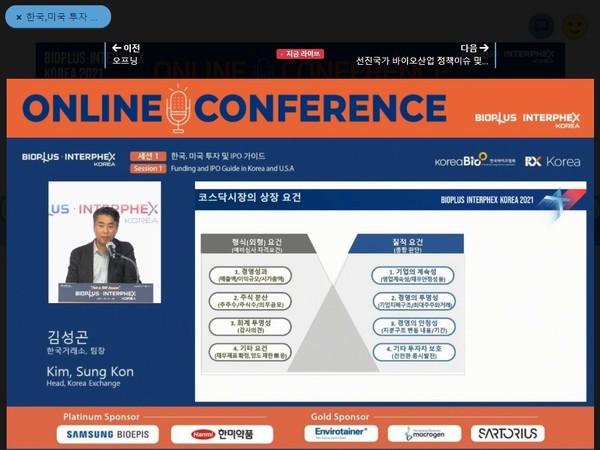“Recently, biotech companies increasingly failed to pass the Korea Exchange’s (KRX) approval for Kosdaq listing or withdrew from assessment, and some speculate the KRX’s review stance might have become more conservative. But this is not true. Rather, biotech firms are rushing to go public because recent IPOs were successful.”
So said Kim Sung-kon, head of the KRX’s innovative growth support division, during his presentation on the “Guide for investment and IPO in Korea and the U.S.” at the virtually-held Bioplus-Interphex Korea 2021 on Wednesday.

He explained the procedure for listing Kosdaq and recent policy changes and particularly noted what biotech companies preparing an IPO on Kosdaq should know.
The tech-heavy Kosdaq market is steadily expanding. The Kosdaq index surpassed the 1,000 mark in the first half, and the market capitalization amounts to 420 trillion won ($359.4 billion). Daily transactions on Kosdaq are worth 10 trillion won, and over 1,500 companies have their names listed on Kosdaq.
“With lots of attention on Kosdaq, 84 companies were newly listed last year. This trend is likely to continue this year,” Kim said. “Compared with Nasdaq of the U.S., Kosdaq is regarded as an attractive market for foreign investors thanks to abundant liquidity and active investment.”
In particular, 25 companies utilized the KRX’s technology exception policy for IPOs from January to September. The number is the largest since the KRX introduced the policy.
However, only eight companies out of the 25 firms were in the biotech industry, and the proportion of biotech firms has shrunk.
This is because the technology exception policy became available to other industries, and platform developers related to the Fourth Industrial Revolution increasingly applied for listing using the policy, Kim said. In addition, the policy makes it easier for companies with superior technologies to go public.
He cautioned against imposing too much meaning on technology evaluation, which is part of the requirements for biotech firms to use the technology exception policy. A biotech company must receive technology assessments from two rating agencies among 22 agencies designated by the KRX and pass the evaluation.
“Technology evaluation is the minimum requirement. It does not mean a review for listing, and it does not affect the KRX’s decision. Then, after that, there is a preliminary review,” Kim said.
Some companies tell the media that they passed technology evaluation and say they had already passed the KRX’s review, but this could give a wrong signal to the market, he warned.
To be listed on Kosdaq, a company should meet both formal and qualitative requirements.
The KRX uses formal requirements as the basis for a preliminary review. Formal requirements include business performance (sales/profit/market cap), stock diversification (number of shareholders/number of shares/obligatory public offering), transparency in accounting (audit opinion), and others (financial statement confirmation, no transfer restriction).
Qualitative requirements include continuity of the company (business continuity/debt safety), management transparency (corporate governance/transactions with the largest shareholder), management stability (changes in equity structure/period), and other investor protection measures (sound stock market development).
Kim said the qualitative requirements have become more important for Kosdaq listing.
“Management transparency and management stability are the most overlooked by entrepreneurs and managers preparing for Kosdaq listing,” he said.
He added that family-owned companies or startups could face trouble if they had insider trading, special benefits for the largest shareholders, or unclear business practices.
The KRX tends to pay special attention to a company if it receives a large amount of external investment early because it would lower the share of the largest shareholder.
He said that a smaller share of the largest shareholder could cause management problems or provide a target for a hostile M&A, he said.
“Some say earnings and good technology would be enough to go public, but the KRX puts great importance on management transparency and stability, so companies should prepare well,” Kim said.
He repeatedly emphasized the importance of picking the right underwriter, saying preparing for the Kosdaq listing was like “getting fit.”
The lead underwriter checks if the company meets the listing requirements, finds and gets rid of any obstacle, Kim said.
It is the lead underwriter, not the company, that communicates with the KRX, he added.
“It is very important to select a smart underwriter.”

